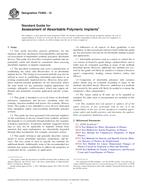Potřebujeme váš souhlas k využití jednotlivých dat, aby se vám mimo jiné mohly ukazovat informace týkající se vašich zájmů. Souhlas udělíte kliknutím na tlačítko „OK“.
ASTM F732-00(2011)
Standard Test Method for Wear Testing of Polymeric Materials Used in Total Joint Prostheses
Automaticky přeložený název:
Standardní zkušební metoda pro nošení testování polymerních materiálů používaných v totálních kloubních protéz
NORMA vydána dne 1.6.2011
Informace o normě:
Označení normy: ASTM F732-00(2011)
Poznámka: NEPLATNÁ
Datum vydání normy: 1.6.2011
Kód zboží: NS-56279
Počet stran: 11
Přibližná hmotnost: 33 g (0.07 liber)
Země: Americká technická norma
Kategorie: Technické normy ASTM
Kategorie - podobné normy:
Anotace textu normy ASTM F732-00(2011) :
Keywords:
joint prosthesis materials, pin-on-disk, wear testing, Fixed-bearing ball-cup wear applications, Hip replacement prosthesis, &ldquo,Hip-type&rdquo, wear test, Delamination, Joint prostheses, Laboratory testing, Linear reciprocating wear motion, Nominally linear motion delamination/wear test, Pin-on-disk evaluation method, Plastic surgical devices/applications, Polymers (surgical applications), Testing methods--surgical implants, Wear testing--surgical implant materials/applications
Doplňující informace
| Significance and Use | ||||||||||||||||
|
This test method is intended to be performed in conjunction with pin-on-flat wear machines or similar machines that are designed to evaluate simplified specimen geometries. This test method is designed to evaluate combinations of materials with respect to the amount of polymer wear, where quantifiable wear occurs primarily on the polymeric component. With some combinations of materials, significant wear of the counterface may occur, with subsequent embedding of counterface debris particles in the polymer. Such an occurrence will render the weight loss of the polymer specimen unreliable as an indicator of the polymer wear. Wear is reported as volume loss of the polymeric specimen as a function of sliding distance; however, if the sliding distance is not constant across the polymeric specimen surface due to complex motion patterns, wear may be reported as volume loss of the polymeric specimen as a function of wear cycles (in which case a “wear cycle” shall be defined). Volume loss of the polymer specimen is determined by dividing the experimental weight loss by the density of the polymer. For ease of interpretation, wear should be reported as a function of both the number of wear cycles and the sliding distance, when possible. The reference for the comparative evaluation of candidate materials shall be the wear rate of ultra-high-molecular-weight polyethylene (UHMWPE) conforming to Specification F648 bearing against counterfaces of cobalt-chromium-molybdenum alloy (in accordance with Specifications F75, F799, or F1537), having prosthetic-quality surface finish and lubricated with bovine blood serum (see 5.2). |
||||||||||||||||
| 1. Scope | ||||||||||||||||
|
1.1 This test method describes a laboratory method for evaluating the wear properties of combinations of materials that are being considered for use as bearing surfaces of human total joint prostheses. The body of this test method contains general methods which apply to all types of prosthesis wear applications while individual annexes describe specific wear test methods and clinical validation criteria tailored to each distinct wear application (for example, linear reciprocating motion, ball-cup (“hip-type”) wear, delamination wear, etc.). It is the intent of this test method to rank materials, within each wear application, for polymer wear rates under simulated physiological conditions. It must be recognized, however, that contact geometries and wear motions are simplified using such methods. This test method, therefore, represents only an initial stage in the full wear characterization of a candidate material. 1.2 All candidate materials should be tested in an appropriate joint simulator apparatus using prototype prostheses before being used in clinical trials in patients. The tests described in this test method are used to quickly and reliably screen material combinations for wear performance in different orthopaedic wear applications prior to committing them to more expensive and time-consuming joint simulator testing. In addition, these simplified tests can be used to relate material, surface finish, or other parameters to wear behavior on a more practical basis than is possible in joint simulator tests. 1.3 The values stated in either SI units or inch-pound units are to be regarded separately as standard. The values stated in each system may not be exact equivalents; therefore, each system shall be used independently of the other. Combining values from the two systems may result in non-conformance with the standard. |
||||||||||||||||
| 2. Referenced Documents | ||||||||||||||||
|
Podobné normy:
Historická
1.1.2010
Historická
1.12.2010
Historická
1.3.2011
Historická
1.12.2010
Historická
1.12.2010
Historická
1.12.2012
Doporučujeme:
EviZak - všechny zákony včetně jejich evidence na jednom místě
Poskytování aktuálních informací o legislativních předpisech vyhlášených ve Sbírce zákonů od roku 1945.
Aktualizace 2x v měsíci !
Chcete vědět více informací? Podívejte se na tuto stránku.



 ASTM F2790-10
ASTM F2790-10 ASTM F2847-10
ASTM F2847-10 ASTM F2885-11
ASTM F2885-11 ASTM F2886-10
ASTM F2886-10 ASTM F2895-10
ASTM F2895-10 ASTM F2902-12
ASTM F2902-12
 Cookies
Cookies
